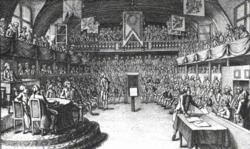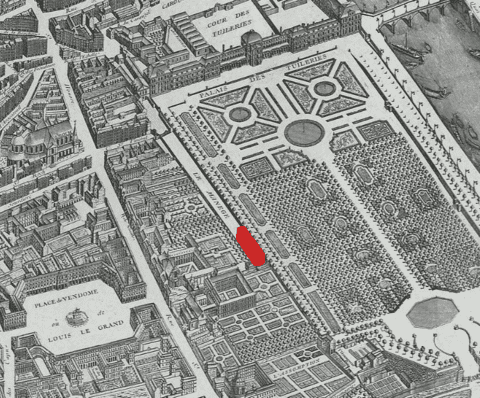 | ||
Installation conque acoustique le grand r salle du man ge
The indoor riding academy called the Salle du Manège ([sal dy manɛʒ]) was the seat of deliberations during most of the French Revolution, from 1789 to 1798.
Contents

Before the revolution, the Salle du Manège ("Riding Hall"), situated along the north end of the Tuileries Gardens to the west of the Tuileries Palace in Paris, was home to the royal equestrian academy. Built during the minority of Louis XV, when it lay conveniently close to the Regent's Palais Royal, it was allowed to pass afterwards from hand to hand as the site of privately conducted riding schools, though it was never formally sold.

On 9 November 1789 the National Constituent Assembly, formerly the Estates-General of 1789, moved its deliberations from Versailles to the Tuileries in pursuit of Louis XVI of France and installed itself in the Salle du Manège on the palace grounds. Having nationalised the goods of the Church, the Assemblée nationale, requiring more space than the Manège alone could provide, extended its occupation to two adjacent convents, those of the Capuchins, which soon housed the Revolutionary printing presses in its former refectory, and of the Feuillants, whose handsome library received the archives of the Assemblée.

The proportions of the Salle du Manège, ten times as long as it was wide, offered poor acoustics for the debates that went on continually under its high vaults. Six tiers of banquettes permitted space for the deputies, ranged on either side of the central tribune, initially planned for the orators' podium. Seated together for solidarity, the deputies seated themselves according to their political opinions, to right and to left of the president's desk, The Mountain and the Girondins, with The Plain seated in the lowest rank of banquettes, from which they were wont to cross to the opposite side, as their opinions dictated. The public found places to witness the spectacle at either end of the hall and in the loge seats above.

In 1792 the Salle du Manège became the venue for the National Convention. In 1795 under the French Directory, the Council of 500 sat in the structure until the body moved to the Palais-Bourbon in 1798. In 1799, the Jacobin Club du Manège had its headquarters there.

It would seem that 19th century references to the art of "manège," to describe a style of equestrian riding, derive from here. A March 1847 edition of The Illustrated London News described a performance of Pablo Fanque, the 19th century equestrian and circus performer thus: "This extraordinary feat of the manège has proved very attractive, as we anticipated in our Journal of last week; and we have judged the success worthy of graphic commemoration..." Further, the paper said, "Mr. Pablo has trained his black mare to do the most extraordinary feats of the manege, an art hitherto considered to belong only to the French and German professors of equitation, and her style certainly far exceeds anything that has ever yet been brought from the Continent."
